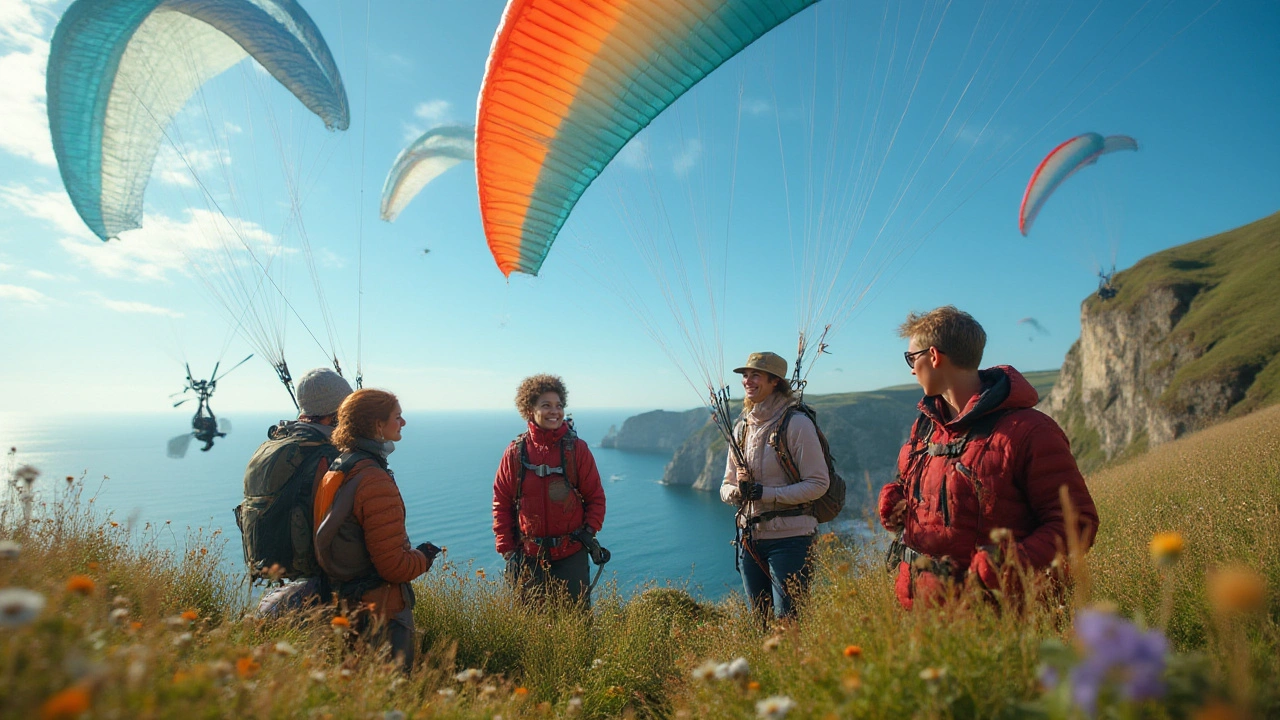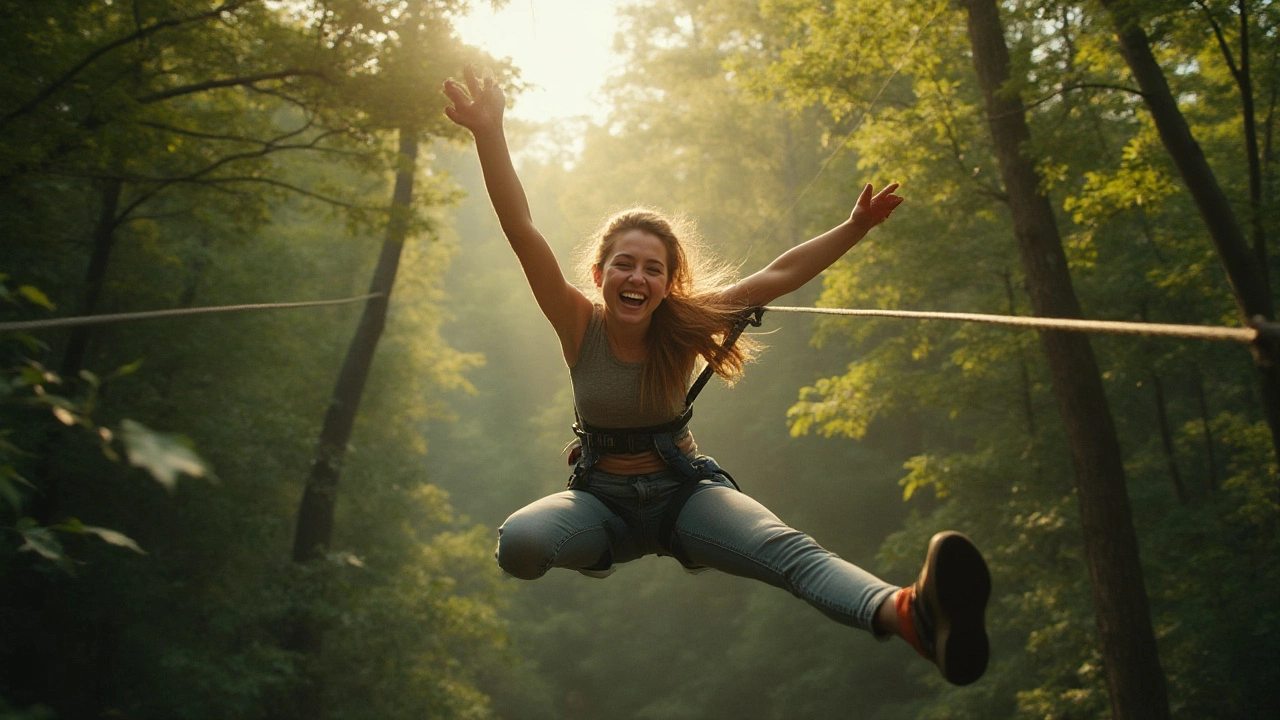5 Recreational Air Activities for Adventure Seekers (With Tips & Facts)
 Jul, 5 2025
Jul, 5 2025
Adrenaline isn’t just for roller coasters or haunted houses. When you think of adventure, what pops into your mind? For me, it’s always heads-in-the-clouds stuff—literally. There’s a wild freedom and crazy thrill that comes from hanging thousands of feet above ground with nothing but air between you and the world below. If you want your heart pounding for all the right reasons, the air is the best playground there is. Let’s talk about the kind of fun that makes your palms sweat, opens up your lungs, and has you grinning for weeks—and yes, it’s all about recreational activities up in the sky.
Paragliding: Glide Like a Modern Icarus
If you’ve ever watched someone seemingly float off a mountain, trust me, it’s every bit as magic as it looks. Paragliding isn’t about dropping like a brick; it’s about riding the currents, catching thermals, and swooping over valleys or beaches. Pilots use a soft, fabric wing—basically, a huge, high-tech parachute. You run a little, the wing fills with air, and suddenly, you’re airborne. It’s both peaceful and exhilarating. You get this insane perspective on the world—tiny cars, rivers that look like tracing lines, forest canopies stretching like broccoli florets.
One surprising fact: Paragliders can stay aloft for hours, sometimes traveling over 300 km in a day during cross-country events. Beginners can usually take a tandem flight with an instructor—a good idea if you don’t want to overthink things. My son Caleb tried it on our trip to Interlaken, Switzerland, and he still brags about it to his friends. The gear is impressively light—you can pack a whole set into a backpack. Most flight schools teach you the basics in a couple of days, and you don’t need to be super fit, just reasonably active. Sunblock is a must though—even short flights can roast your nose without you noticing.
Some of the top spots? Pokhara in Nepal is jaw-dropping, Hawaii’s Oahu north shore gives you volcano views, and Oludeniz in Turkey lets you swoop down over turquoise water. Always check wind reports, know your landing options, and never let pride override logic—if the pros stay grounded, so should you.

Skydiving: Pure, Unfiltered Adrenaline
If there’s one air activity that consistently tops “bucket list” articles, it’s skydiving. It’s basically controlled falling at terminal velocity, and it’s the only time you’ll freefall through the air at 200 km/h (about 125 mph) with your heart threatening to jump out of your ribcage. The cool part is the contrast: first you’re hurtling, then after the parachute yanks open, you float gently down with a sprawling view all the way to the horizon.
Modern parachutes are crazy reliable. According to the United States Parachute Association, the average rate of injuries is about 0.39 per 1,000 jumps, and fatality rates are lower than you might think: about 1 in 220,000 jumps in 2023. You generally need to do tandem jumps with an instructor for your first few jumps (unless you want to invest weeks in getting a solo qualification). There’s a lot of safety obsession in the sport—gear checks, training, backup parachutes. If you follow the plan, it’s not nearly as risky as most people imagine.
What’s the best part? For me, it’s always been the sensory overload. You hear nothing except the whistling wind, and time feels stretchy and strange. Daphne, my daughter, once told me that her first solo jump felt like she left her nerves on the runway. If you want a ridiculous Instagram shot, there’s nothing that beats a group freefall photo. One tip: eat light. Trust me, you don’t want a full breakfast rocketing through your system at 10,000 feet.
Skydiving fields and clubs are everywhere. The popular sites include Perris Valley in California, Dubai (with views of the iconic Palm Islands), and Queenstown in New Zealand. Don’t forget a GoPro and double-check your shoes—they should be snug, or you’ll be the only person in history to lose a sneaker at 12,000 feet.
| Activity | Average Duration | Minimum Age | Global Injury Rate |
|---|---|---|---|
| Paragliding | 20-60 min (recreational) | 14 yrs (with guardian) | Approx. 0.12 per 1,000 hours |
| Skydiving | 5-7 min (jump to landing) | 18 yrs | 0.39 per 1,000 jumps |

Hot Air Ballooning, Hang Gliding & Ziplining: Floating, Soaring, Zooming
Not into heart-thumping drops? Don’t sweat it—air fun isn’t all about adrenaline rushes. Hot air ballooning is the most peaceful way to leave the ground. It’s the oldest air activity—people were floating around Paris way back in 1783. The science is simple: hot air rises, so when you heat the air in the balloon, the whole rig floats. The view is quiet and dreamy. No motor noise, just the occasional WHOOSH when the pilot fires the burner.
Surprise: The world record for highest manned balloon flight is over 21 miles up. That’s 5 times higher than Mt. Everest. For regular flights, though, you’re hovering just a couple thousand feet up. It’s slow, it’s peaceful, and you often drift wherever the wind takes you—literally. That’s why you’ll see balloon chase crews ready to pick you up wherever you land. A tip? Bring binoculars. You’ll spot deer, herons, rooftops…sometimes curious dogs barking at you from backyards.
Hang gliding is a step up for adrenaline junkies who still want that floating-bird feeling. The gliders are rigid, triangle-shaped wings you steer with your body. You need a running start off a hill or launch ramp. Then you’re riding thermals and gliding for miles. Top pilots can stay airborne for hours, hit altitudes of over 5,000 meters, and crack speeds of 80 km/h (50 mph). There’s more technical skill involved, so training is longer—typically 10-20 lessons to solo. You’ll burn a ton of calories too. It’s like piloting with your whole body. For first flights, go tandem with an instructor and remember: helmet always on.
Last up, ziplining. Maybe you think ziplining is just for kids’ parties, but let me tell you—zipping over a jungle canopy at 60 mph isn’t for the faint-hearted. Modern ziplines span entire valleys. The world’s longest, in the UAE, is nearly 3 km (over 1.7 miles) long. Some ziplines drop over 600 meters, steeper than most ski runs. It’s accessible and family-friendly—Daphne’s favorite, hands down, because you can go in pairs and compete for the loudest scream. It’s also the safest—most injuries happen when people fool around on the platforms, not during the ride. Closed-toe shoes are a must, and pocket contents should zip shut or stay behind (phones and keys go flying way too easily).
| Activity | Record | Coolest Site | Skill Needed |
|---|---|---|---|
| Hot Air Balloon | Stratospheric flights (21 miles up) | Cappadocia, Turkey | None (pilot controls balloon) |
| Hang Gliding | Flights over 300km nonstop | Kitty Hawk, USA | Body steering, course training |
| Ziplining | Longest: 2.83km (UAE) | Monteverde, Costa Rica | Minimal—listen to guides |
What’s the secret to enjoying any of these activities? Simple: respect the weather, trust your instructors, hydrate, and wear the right gear. These sports have gotten safer and easier than ever, and operators are strict—nobody wants trouble a mile up. For families, hot air ballooning or ziplining work well even for youngsters (kids as young as seven can join in zipline fun with most operators) and are great intro experiences. If you’re looking to shift your perspective, conquer a fear, or just get your heart racing (in a good way), spending time above ground is the way to go. My own memories, with Caleb nervously gripping my hand at the balloon basket and Daphne soaring overhead on a canopy zip, beat any video game or movie night—there’s just nothing like the real thing up there in the open sky.